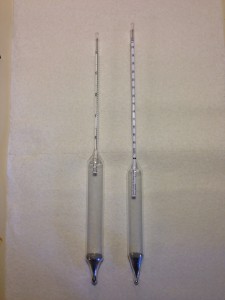 Most of the time, when we miss our target original gravity (OG), we are low. However, it can happen that your extract efficiency is higher than you expect and your OG ends up being higher than you planned for. The most frequent causes of this adjusting your grain mill to a smaller gap, using a new base malt, or just learning the ropes and starting to get the hang of things. As with coming in low, you have a couple options.
Most of the time, when we miss our target original gravity (OG), we are low. However, it can happen that your extract efficiency is higher than you expect and your OG ends up being higher than you planned for. The most frequent causes of this adjusting your grain mill to a smaller gap, using a new base malt, or just learning the ropes and starting to get the hang of things. As with coming in low, you have a couple options.
The first option, of course, is to just accept the higher OG and brew a stronger beer than you intended. If you were brewing a hoppy beer, you might want to adjust the hop amounts up slightly to take the lowered hop utilization into account. However, unless you’re way over your target OG, you can probably just add your hops as planned and be fine.
Add Water
The second option is to dilute your wort with water such that you hit your target original gravity, but yield a larger volume of wort. For example, let’s say you intended to brew 5.0 gallons of pale ale, with an expected OG of 1.048. (As with the first two installments of this article, I’ll work the examples in English units. The math works the same using metric units, just use liters instead of gallons.) You collect 6.5 gallons of wort and find is has a specific gravity of 1.046. Boiling it down to 5.0 gallons will yield a 5.0-gallon post-boil SG of 1.060 — quite a bit over the target. (To estimate your post-boil SG from the pre-boil volume and SG, use the “CV” equation.)
If you really wanted to hit 1.048, you’d have two options. The first would be to boil the 1.046 pre-boil wort down to 1.048. In this case, this would likely be a bad idea because you would not have enough time for all the hop additions. If you were closer to the mark, boiling for a shorter time can be an option. In this case, however, your best bet is to dilute the wort such that — at the end of your boil — you reach SG 1.048.
Again, the CV equation will help estimate what you need to do. First, calculate the volume of wort you will have when you reach your target post-boil AG. In this instance, you would hit 1.048 when the wort was boiled down to 6.2 gallons. Second, use your boil off rate to estimate how much water to add. What pre-boil volume will lead to a post-boil volume of 6.2 gallons after your planned boil time? For the sake of simplicity, let’s say you boil off 1.0 gallon of wort per hour. In this case, you would then need to add 1.0 gallon to 6.2 gallons for a 60-minute boil. (Add 1.5 gallons to 6.2 gallons for a 90-minute boil.)
Finally, add water to reach that calculated volume. If you needed 7.2 gallons of wort to yield 6.2 gallons at your target post-boil SG, but already had 6.5 gallons collected, add (7.2-6.5=) 0.7 gallons.
Expanding the volume of your wort also means you will need to add proportionally more hops. To scale these amounts up proportionally, take the volume of wort you ended up with divided by the volume of wort you originally planned — in this case 6.2/5.0 — and multiply each hop amount by this fraction. Depending on what you’re brewing, you may need to scale up other kettle additions.
Yielding more post boil wort also likely means you’ll need to clean and sanitize a second fermenter. And finally, if you made a yeast starter, you will be pitching it to a larger volume of wort than you intended. As such, you will be pitching at a lower rate than you intended. In most cases, the relatively small change in pitching rate shouldn’t have much effect. However, if you have any “extra” yeast on hand — perhaps a sachet of dried yeast — you might want to try to make up the deficit.
Recap and Conclusion
Missing your target OG is something every brewer is going to face. It’s easiest to just take accept a specific gravity close to your target, but sometimes you are far enough off that you’ll want to correct for it. Two methods of correcting for a low OG are to boil the wort longer or to add malt extract in the kettle. And, as outlined above, you can correct for a high OG by adding water. In order to implement any of these fixes, you’ll be best off estimating your OG (or post-boil wort volume) by using the “CV equation.” That way, you’ll know you have a problem at the start of the boil — and you’ll have some time to fix it.
If you do miss your target OG by much, take good notes during your brewing session and try to pin down the cause, to prevent it from occurring again. Reviewing the major variables that cause differences in extract efficiencies will let you now what to look for.
—
Related Articles

Speak Your Mind